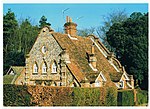Gatehampton Railway Bridge

Gatehampton Railway Bridge, otherwise referred to as Gatehampton Viaduct, is a railway bridge carrying the Great Western Main Line over the River Thames in Lower Basildon, Berkshire, England. It takes the line between the stations at Goring and Streatley and Pangbourne, and crosses the Thames on the reach between Whitchurch Lock and Goring Lock. The western viaduct is the older of the two, having been engineered by Isambard Kingdom Brunel and was constructed at the same time as Maidenhead Railway Bridge and Moulsford Railway Bridge. It was built between 1838 and 1840, opening later that same year. A second phase of work, conducted between 1890 and 1893, involved the construction of the east relief bridge along with the refurbishment of the west bridge. They have become prominent manmade features of the local riverside landscape; on 19 June 1984, they became formally protected as a Grade II listed structure.
Excerpt from the Wikipedia article Gatehampton Railway Bridge (License: CC BY-SA 3.0, Authors, Images).Gatehampton Railway Bridge
Reading Road,
Geographical coordinates (GPS) Address External links Nearby Places Show on map
Geographical coordinates (GPS)
| Latitude | Longitude |
|---|---|
| N 51.511666666667 ° | E -1.1279166666667 ° |
Address
Gatehampton Railway Bridge
Reading Road
RG8 9NG , Basildon
England, United Kingdom
Open on Google Maps










